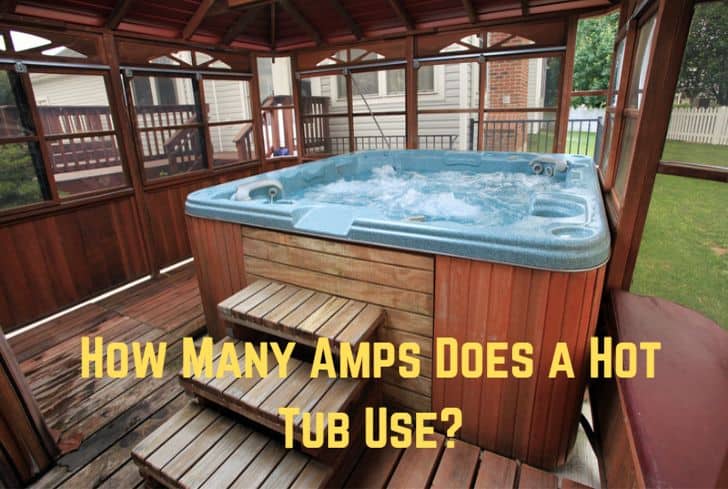Who doesn’t enjoy a nice, relaxing soak in a hot tub after a long day? Hot tubs are a great way to unwind, relax, and enjoy some quality time with friends or family. But before you invest in that bubbling oasis of relaxation, ensure that you have the right electrical setup to support it. So, how many amps does a hot tub require?
Well, in this blog post, we’ll outline everything you need to know about the amperage a hot tub will require, including a few things to know before installation. So, whether you’re a first-time hot tub owner or a seasoned veteran, read on for all the info you need to make sure your electrical system can support your new purchase.
Read: How Many Amps Does a Dehumidifier Use?
How Many Amps Does a Plug and Play Hot Tub Use?
A plug-and-play hot tub will use an amperage range of 30-60 amps, with 50 and 60 amps being the most common. Actually, if you want to enjoy all the features and full functions of your hot tub to the fullest, you’ll need a 50 or 60 amp circuit.
A hot tub is one of the best things you can bring into your home. They provide a place for you to relax after a long day, entertain guests, and even increase the value of your home. But before you make your purchase, it’s imperative to ensure that your home can handle the electrical load of a hot tub.
And if you’re buying anything close to a typical hot tub, you’re going to need at least 50 amps of power. In fact, most hot tubs on the market these days require between 50 and 60 amps to run properly. That’s at 220 – 240 volts, by the way.
Now, you might be thinking to yourself, “my home only has 30 or 40-amp service, can’t I just use a lower-powered hot tub?” The answer is no, you cannot. If you try to use a 50 or 60-amp hot tub on a lower-amp electrical system, you’re going to run into all sorts of problems.
Your hot tub won’t do the heating properly, the jet pumps will be weak, and you’ll probably trip a breaker every time you try to use it. So, if you’re serious about getting a hot tub, you’re going to need to upgrade your electrical service to accommodate it.
Can a Hot Tub Share a Circuit?
No, don’t try to have your hot tub share a circuit with other appliances. It’s dangerous and you could run into all sorts of electrical problems. Always use a dedicated circuit for your hot tub that is at 220-240 volts.
Most appliances around the home work well even when sharing a circuit. But the same can’t be said for hot tubs. As such, as you invest in a decent hot tub, spare a few bucks to direct into your home’s electrical system as well.
Hot tubs need a lot of watts to run, and that’s the reason having its own circuit is critical when doing the wiring. The dedicated circuit will supply power not only to the unit but also to other appliances related to the unit; the pump, jets, heater, and other spa appliances that run on electricity.
With all these parts working in tandem, it would be best if your hot tub doesn’t share power with other devices. It will ensure that you get the best out of each of these devices, and your hot tub experience will be more enjoyable.
Additionally, by having a dedicated circuit, you can avoid any electrical accidents that might occur should another appliance overload the electrical circuit, thereby causing a power outage.
What is the Required Breaker Size For a Hot Tub?
The required circuit breaker size for a hot tub depends on the size and features of the hot tub. But on average, most hot tubs need at least 50 amps and a voltage of 220 – 240 volts. In fact, most hot tubs on the market these days require between 50 and 60 amps to run properly.
That’s not to say that you can’t get a unit that works with less power. You can find a few models that only need 30 or 40-amp power. But those are mostly the lower-end models, and they may not provide the features or power that you’re looking for.
So, to get the best out of your investment and avoid likely electrical problems, it’s advisable to go for a larger size breaker that’s at least 50 amps. Anything less than that is likely to give you subpar results.

Is a GFCI Breaker Required For a Hot Tub?
Yes, all hot tubs must use a Ground-Fault Circuit Interrupter (GFCI) breaker. A hot tub is one of the likely places where electrocution might occur. So, it really makes a lot of sense to have this safety feature in place.
GFCI breakers work by sensing any changes in the current flowing through the circuit. If there’s a sudden drop or an increase in the flow of current, it trips and cuts off the power supply, thereby preventing electric shock.
Ground fault circuit interrupter is one of the must-have for all installations where water contact is likely. That’s according to the National Electrical Code (NEC), and your hot tub is one such installation. So, when you’re getting your hot tub’s electrical system set up, make sure that a GFCI breaker is part of the equation. It could save your life.
And when installing one, it’s advisable to use professional installation services. Get a licensed electrician to do the job. A GFCI is such a critical component of the electrical system, and you really don’t want to take any chances with it.
Of course, a licensed electrician will charge you for all that electrical work. But that’s a small price to pay for peace of mind and safety.
Read: How Many Amps Does a Ceiling Fan Use?
Can a Hot Tub Run on a 30 Amp Breaker?
You can use a 30-amp breaker for a hot tub, especially if you have one of the smallest hot tubs. But again, it’s not recommended since it just won’t give you the experience you need when you soak yourself in a hot tub.
You see, as much as we have some smaller hot tubs with a small amperage draw, most of them still require at least 50 amps. A 30-amp breaker may keep on tripping whenever you turn the unit on, and that can be quite frustrating.
Moreover, you need to consider the 80% NEC rule when sizing a breaker for your hot tub. That rule stipulates that you should never use more than 80% of the breaker’s capacity. So, for a 30-amp breaker, you should only use 24 amps.
But as we’ve already established, most hot tubs require at least 50 amps. So, using a 30-amp breaker is really not ideal. It would really bring down the whole experience.
Why Can’t You Use an Extension Cord on a Hot Tub?
You can’t use an extension cord on a hot tub because it’s likely to bring down the voltage to levels that are beyond what’s ideal for the hot tub. That, in turn, can lead to overheating and can stir danger to the users.
Extension cords are a great investment we all love to have around the house. But they’re not ideal for everything. For instance, you wouldn’t use one for your fridge or your microwave. You’d rather connect them directly to the electrical outlet. And yes, it doesn’t end in the kitchen!
When you move to the bathroom, this electrical device will neither be ideal for your hot tub. You see, the cord increases the distance between the power source and the appliance. And as you know, that weakens the current.
And when the current gets weaker than what’s necessary, it means that whatever you’re likely to get isn’t going to be as good as what you would have gotten if the current was stronger. And more likely for hot tubs, this unit will result in accidents.
So, if you were considering getting one alongside other supplies for your hot tub, you might want to think again. It’s definitely not something you should have on your list.
Read: How Many Amps Does an Electric Blanket Use?
Frequently Asked Questions (FAQ’s)
Are Hot Tubs 50 Or 60 Amps?
It depends on the size and features of the hot tub. The vast majority of hot tubs require at least 50 amps, with some models requiring up to 60 amps. However, some models of smaller hot tubs may only require 30 amps.
Will A 40 Amp Breaker Run a Hot Tub?
It is possible to run a hot tub on a 40 amp breaker if its amperage draw is within the 80% NEC rule. That means if the amp draw is below 32 amps, you may be able to get away with it. But for most hot tubs, this isn’t going to be enough power.
How Deep Should You Bury Wires To a Hot Tub?
You should bury the wires in a hot tub at least 18 inches deep. However, it’s always best to check with your local building codes to see what the requirements are in your area. Plus, unless you are a professional electrician, it’s best to hire someone to do this job for you. Hot tub installation doesn’t fall in the realm of most do-it-yourself skills of most homeowners.
Final Verdict
A hot tub installation will bring a lot of fun right into your house. It will provide you with a great place to relax after a long day at work or to entertain guests. But before you get too excited, you need to make sure that your electrical system is up for the task.
Make sure it can deliver about 50-60 amps, and that you have the right breaker in place. And as usual, check the manual of your spa for specific requirements. And when it comes to installation, always work with the manufacturer or a qualified electrician to get the job done right.






